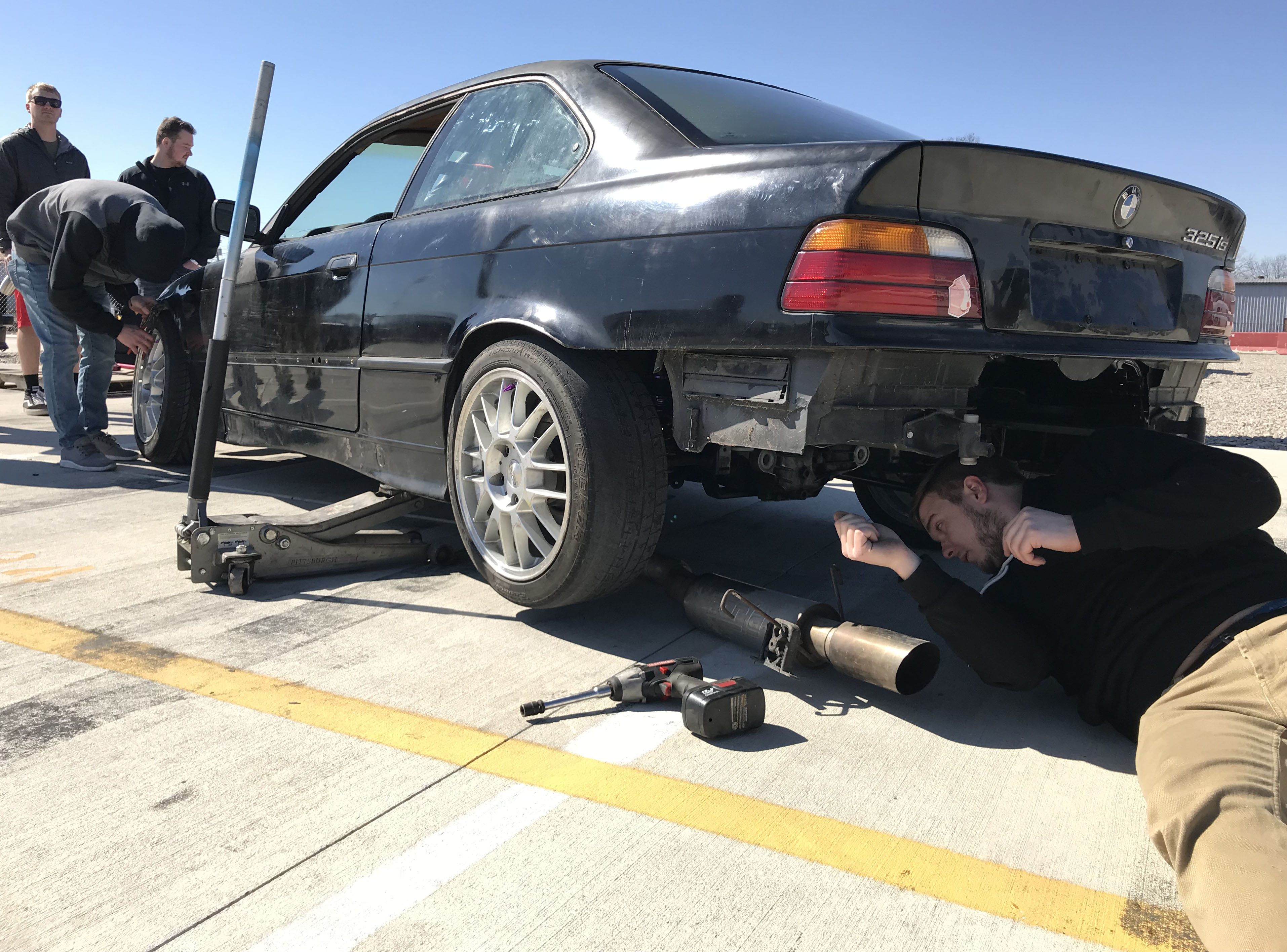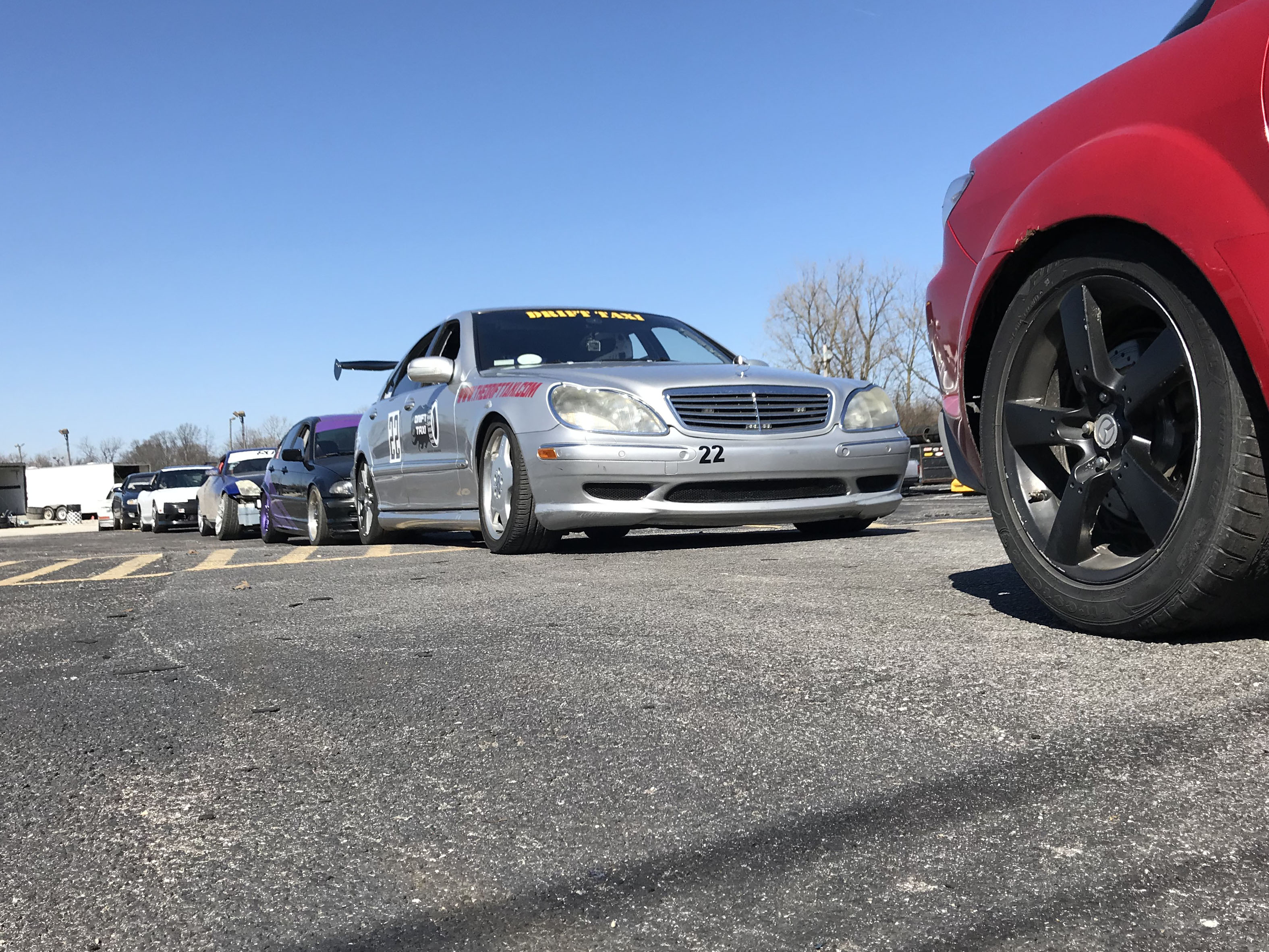A community forms around those who don’t see vehicles as just a means of transportation, but rather as a lifelong passion worth the hours spent in the garage.
On a cold winter weekend, breath visible indoors and out, the jet heater roars to life as it starts pumping out vital heat. The seemingly-abandoned, seafoam green, four-bay garage slowly fills up with heat. Cars and car parts litter the area—enough to make a junkyard proud.
They represent the blood, sweat, and sometimes even tears that go into a hobby and a passion.
As the morning turns into day, more people show up to the garage to get started on their projects. Soon the room is filled with the smell of cigarette smoke and e-vapor, the roar of the jet heater, background music, and the rhythmic sound of ratchets and tools at work.
When that much time and effort go into something, people feel they put a piece of themselves into it.
The Foundation
Drake Dillard is a senior at Ball State University. His weekends are not filled with homework or partying, but instead with greasy hands, busted knuckles, and a sense of accomplishment and pride.
The 2018 drift and car season started on March 4.
Meets are like show-and-tell for cars. Drifting is a motorsport in which people try to make the back end of a rear-wheel driven car slip and lose traction while going around a curve, resulting in the car being oversteered, but the driver still has control over it. The car will go sideways through a corner when done correctly.
Drake is working on getting his third BMW 325i E36 ready for upcoming car meets.
He isn’t alone in this; other car fanatics are getting ready for the 2018 season of racing and car meets. There are a variety of groups and communities dedicated to cars on Facebook alone. Just looking up “Muncie Cars” on Facebook will show there are 759 people who either follow or are a part of a group or community that is involved with cars.
Muncie used to be a center of car parts production. It drove the economy forward and supplied much of the growth that fueled the expansion of the middle class in Muncie and the expansion of the city, says James Connolly, director of the Center for Middletown Studies at Ball State.
In the early 20th century, Muncie used to even have its own vehicle manufacturing plants—Durant, Interstate, Rider-Lewis, Standard, and Sheridan. These companies eventually gave way to the car makers in Detroit, and Muncie went from making cars to making parts for cars instead, Connolly says.
These factories brought in lots of wealth for the community and, at one point, employed as many as 11,000 people during peak production.
Now the foundation of wealth that brought the community prosperity is gone. The last unionized factory closed up shop in 2009. The BorgWarner factory, famous for the Indy 500 BorgWarner trophy, was demolished in September 2017, ending an era that shaped the city into what it is today.
Although most of the factories are almost gone, the city still has pride in the nostalgic memory of the past. People online and in car subcultures praise the once-mighty Muncie transmission that used to be manufactured here.

The Culture
Drake wasn’t always into cars. At his high school in Cowan, Indiana, he was more into basketball. He didn’t get into cars until his junior year, when his friend Brad Perry told him they should visit the career center together to learn about automotive careers.
Brad used to tinker with his father’s lawnmowers as a child, trying to take them apart and put them back together. Sometimes he was successful, sometimes he wasn’t. Sometimes his father knew about it, and sometimes he didn’t.
Brad says cars were always a little harder for him to understand, so he decided to take a class to learn more about them.
Drake and Brad continued to work on cars and take car classes throughout the rest of high school. They both had their project cars that doubled as daily drivers—meaning they weren’t perfect and needed work, but Drake’s Honda Civic and Brad’s 1985 Chevy El Camino got them where they needed to go.
After high school, Drake went to Ivy Tech Community College for three years, where he and Brad bought their first race car together.
“It was ours. It was a white 325i, 1992, rusty as hell, get tetanus just looking at it,” Drake says of his BMW E36. Eventually, Brad lost interest in the actual fixing aspect of car culture, so Drake bought his half of it and continued to work on and drive it.
On an overcast day in early June, Drake and his crew went up to Fort Wayne to go drifting at Baer Fields Speedway. Normally, he does two laps around the track and then switches out his tires for a fresher set. This time, he thought his tires were still good and tried to go for a third lap.
That was when he made his mistake.
He came around turn two on the back stretch of the track. He forced the car to drift, manipulating his tires to skid across the track, for too long. It caused him to veer into the wall. He wasn’t used to this kind of track. Normally they go to the Speedrome in Indianapolis, which is a 40 to 50 mph track.
Here, he lost control at 70.
The speed of the track is determined by the average speed that most cars go around it. This is due to the shape and size of the track. For example the Indianapolis Motor Speedway is a 230 mph track due to its long straights and steep banked curves that allow cars and drivers to push it over 200.
Drake hit the dirt, tried to initiate the drift too late, and couldn’t scrub off the speed. He hit the walls hard at 60 mph. His drift was going fine until he came out of it and couldn’t steer his car toward the track. It kept going toward the white tire wall.
He spun his car backward, trying to correct it and get back onto the track, but the momentum kept him going in the same direction, only backwards. He tried to correct his loss of control but ended up ripping off his front bumper and tearing up his frame. His car wasn’t salvageable.
Drake didn’t get hurt. Brad, who was in the car with him, got a minor cut on his arm.
Since they totaled the original E36, they had to start from the beginning again. They went out and bought another BMW for $500 to begin the process over again.

The Pay Off
Drake, who is working on his double major in business administration and logistics supply chain, says finding time to work on his car and focus on his classes is difficult.
He leaves for school at 8 a.m. and doesn’t get home until 9 p.m. He eventually told his classmates to not include him in group meetings on the weekends so he could have those dedicated to working on his car.
When he is not working on his car, he feels more relaxed because that means his car is ready to go for the next event. He can use his time to do other things he enjoys, like play video games. But while Drake mostly worries about time, Brad worries about his family.
Brad’s family, in particular his mom, doesn’t approve of him spending time and money on cars. Their main problem is that the cars and tools just sit in the garage most of the time. He has four cars now, but he used to have two more. There are still a couple welders, one that cost $2,000, sitting in the garage collecting dust. He’s only used them three times each, he says.
This all does serve a purpose, though. It gives Drake and Brad a sense of pride and accomplishment. Drake finds the most pride in taking others with him on his drift runs. Taking strangers on runs, handing them the helmet, and telling them to get in is a joy for him. He never goes out on the track by himself.
Social media has played a role in his pride, too. He is well regarded on Facebook pages involving cars and E36s in particular. People in other countries even seek out his advice on issues. People look up to him and come to him when they have questions, Drake says.
He never had many friends before getting into cars, but the culture has provided a community where he feels at home.







